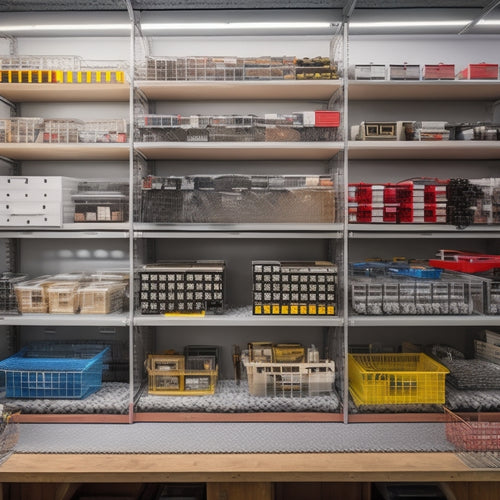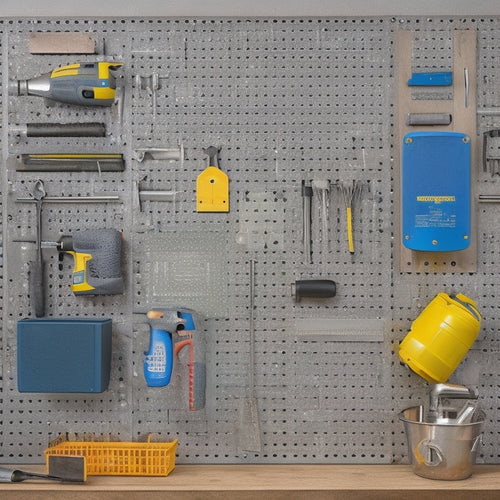
DIY Garage Overhead Storage Installation
Share
You're about to change your garage's wasted overhead space into a functional storage area, but first, you need to assess your garage ceiling's load-bearing capacity, which is typically overlooked but vital for a safe and successful DIY installation. Measure your garage height to guarantee a minimum clearance of 12 feet, inspect ceiling materials, and identify existing features that may affect installation. Next, choose the right storage system type, gather necessary tools and materials, and prepare the storage area. With a solid plan and precise measurements, you'll be ready to start installing your overhead storage system - and that's just the beginning of optimizing your garage's storage potential.
Key Takeaways
- Assess garage ceiling height, materials, and obstructions to determine mounting hardware requirements and load-bearing capacity.
- Choose a storage system type (shelving, racks, bins) that aligns with specific storage needs and available space.
- Maximize vertical space by categorizing items into frequent-use and seasonal categories, and distribute weight evenly.
- Gather necessary tools and materials, including a cordless drill, level, and high-quality lumber, and follow manufacturer's instructions.
- Ensure a safe workspace by clearing the floor, sweeping and cleaning the area, and removing existing shelves or obstructions.
Assessing Your Garage Ceiling
As you stand in your garage, gaze upward, and take stock of the overhead space. Evaluating your garage ceiling is essential for a safe and successful overhead storage installation.
Begin by measuring the garage height, confirming you have sufficient clearance for the storage system and easy access. A minimum of 12 feet is recommended for most systems.
Next, inspect the ceiling materials. Identify whether it's drywall, plywood, or another material. This will help you determine the type of mounting hardware required.
Pay attention to any existing features like ceiling fans, light fixtures, or ductwork that may affect the installation. Check for any signs of water damage or structural weaknesses that could compromise the installation.
Verify the ceiling's load-bearing capacity, making sure it can support the weight of the storage system and the items you plan to store.
Consider consulting with a professional if you're unsure about any aspect of the evaluation. A thorough evaluation will guarantee a safe and successful installation, giving you peace of mind and a functional garage overhead storage system.
Choosing the Right Storage System
You'll need to determine your specific storage needs, considering the types and quantities of items you want to store, as well as any size or weight constraints.
Next, you'll select a storage system type, such as shelving, racks, or bins, that aligns with your needs and available space.
Storage Needs Assessment
Determining your storage needs is a critical step in selecting the right garage overhead storage system. You must take a closer look at what you need to store and how you want to organize your garage space.
Start by taking a storage inventory: gather everything you want to store and group items by category, such as seasonal decorations, out-of-season clothing, or tools. This will give you a clear representation of what you need to accommodate.
Next, consider your organization strategies. Think about how you want to access your stored items: do you need easy access or can items be stored out of the way?
Do you have any heavy or bulky items that require special consideration? Take note of any specific requirements, such as ventilation or lighting needs.
System Type Selection
With your storage needs assessment in hand, it's time to select the right garage overhead storage system. You'll want to take into account factors like load capacity, durability, and ease of installation. Three common types of suspension systems are available: fixed, adjustable, and hybrid.
| System Type | Description | Load Capacity |
|---|---|---|
| Fixed | Fixed systems are mounted directly to the ceiling, providing maximum stability. | 250-500 lbs |
| Adjustable | Adjustable systems allow for vertical movement, making it easy to access stored items. | 100-300 lbs |
| Hybrid | Hybrid systems combine fixed and adjustable features, offering flexibility and stability. | 200-400 lbs |
| Ceiling-Mounted | Ceiling-mounted systems attach directly to the ceiling, providing maximum clearance. | 150-350 lbs |
| Wall-Mounted | Wall-mounted systems attach to the wall, ideal for smaller storage needs. | 50-200 lbs |
When selecting a system, verify it meets your load capacity requirements and complies with local building codes. Always prioritize safety and think about consulting a professional if you're unsure about any aspect of the installation process.
Space Utilization Plans
How can you maximize your garage's vertical space while guaranteeing easy access to your stored items? To create an efficient space utilization plan, start by categorizing your items into frequent-use and seasonal categories. This will help you determine the best vertical storage solutions for each type of item.
For frequent-use items, consider installing shelves or hooks near the front of your garage for easy access. Seasonal items, such as holiday decorations or winter clothing, can be stored in bins or containers on higher shelves, keeping them out of the way but still accessible when needed.
When planning your space, consider the weight capacity of your storage system and the items you'll be storing. Make certain to distribute the weight evenly to prevent structural damage or collapse.
Measure your garage's ceiling height and door openings to guarantee your storage system fits comfortably. Organize your items by size and frequency of use, and group similar items together to create a logical and functional storage system.
Gathering Necessary Tools and Materials
You'll need a solid set of tools and materials to create your DIY garage overhead storage system. Start by gathering essential tools like a cordless drill, impact driver, level, tape measure, wrench, and socket set. Organize them in a designated area to guarantee easy access and efficient workflow.
For material selection, choose high-quality lumber, such as 2x4s or 2x6s, depending on the weight capacity you need. Select durable and weather-resistant materials for the storage bins or baskets to withstand the garage environment. Consider using galvanized or stainless steel for the framing and hardware to prevent rust and corrosion.
Additionally, you'll need screws, nuts, and bolts to assemble the storage system. Don't forget to pick up safety gear like gloves, safety glasses, and a dust mask to protect yourself during the installation process.
Always follow the manufacturer's instructions and take necessary safety precautions when working with power tools and materials. By having the right tools and materials, you'll be well-prepared to tackle your DIY garage overhead storage project.
Preparing the Storage Area
Now that you have the necessary tools and materials, it's time to prepare the storage area for your DIY garage overhead storage system. This essential step will guarantee a safe and efficient installation process.
Start by clearing the floor and surrounding areas of any obstacles, debris, or tripping hazards.
To prepare the storage area effectively, follow these steps:
-
Clear the floor: Remove any items that could interfere with your work, such as tools, sports equipment, or storage bins.
-
Sweep and clean: Sweep the floor to remove dirt, dust, and debris, and then clean the area with a damp cloth to prevent dust from rising during installation.
-
Remove obstructions: Take down any shelves, hooks, or other obstructions that may be in the way of your overhead storage system.
- Organize cables and wires: Use storage organization tips to keep cables and wires organized and out of the way, preventing tripping hazards and guaranteeing a smooth installation process.
Measuring and Marking the Ceiling
You'll need to accurately measure your ceiling to guarantee your storage system fits properly.
Take precise measurements of the ceiling's length, width, and any obstructions like vents, pipes, or light fixtures.
Next, mark the ceiling with a pencil, using a level to guarantee straight lines, to guide your installation.
Ceiling Measurement Essentials
Accurate ceiling measurements are essential to confirm your DIY garage overhead storage project turns out as planned.
You'll need to measure the ceiling height, load capacity, and other critical factors to guarantee a safe and functional storage system.
To take accurate measurements, follow these steps:
-
Measure the ceiling height: Record the distance from the garage floor to the ceiling. This will help you determine the maximum storage height and confirm your storage system fits comfortably underneath.
-
Check the load capacity: Verify the weight limit of your garage ceiling to ensure it can support the weight of your storage system and its contents.
-
Identify the ceiling type: Determine if you have a drywall, drop ceiling, or exposed beam ceiling, as this will affect the installation process.
- Locate any ceiling obstructions: Note any pipes, ducts, or electrical wiring that may interfere with your storage system installation.
Ceiling Obstruction Check
As you've determined the ceiling height, load capacity, and type, it's time to identify and map out any obstacles that could hinder your DIY garage overhead storage project.
You'll need to inspect the ceiling to locate any obstructions that might interfere with your storage installation. Check for ductwork, vents, pipes, and electrical wiring that may be running across the ceiling. Make note of their location, size, and distance from the walls.
Next, measure the distance between each obstruction to guarantee you have enough clearance for your storage system. Consider the load capacity of your chosen storage solution and the weight it will hold. You don't want to install a system that's too heavy for the ceiling or one that will be compromised by an obstruction.
Take precise measurements and record them to create a detailed map of your ceiling's obstacles. This will help you plan your installation strategy and avoid any potential hazards.
With this information, you'll be able to design a safe and functional overhead storage system that meets your needs and complies with the ceiling's limitations.
Ceiling Marking Methods
Measure the ceiling's dimensions carefully to create a precise map of the space where you'll install your overhead storage system. This step is essential to guarantee a safe and successful installation.
To mark the ceiling effectively, you'll need to use the right marking techniques. Here are some tips to follow:
-
Use a laser level to project a level line across the ceiling, which will help you identify any uneven areas.
-
Measure from the wall to determine the ceiling height and mark the center point of each joist.
-
Mark the location of any obstructions, such as vents, ducts, or pipes, to avoid them during installation.
- Use a chalk reel to snap a line along the ceiling, creating a grid pattern to guide your installation.
Installing the Storage Rack
Your garage's ceiling is about to become a precious storage space. Now that you've marked the ceiling, it's time to install the storage rack.
Begin by gathering all the necessary hardware, including the rack's mounting brackets, screws, and washers. Verify you have a sturdy ladder and a reliable helper to assist with the installation. Always follow safety guidelines, such as wearing protective gear like gloves, safety glasses, and a hard hat.
Next, locate the marked ceiling points and hold the mounting brackets in place. Use a level to verify the brackets are perfectly horizontal. Drill pilot holes for the screws, then secure the brackets to the ceiling joists with the provided screws and washers. Make sure they're tightly fastened to support the weight of the storage rack and its contents.
Installation tips: Use a stud finder to locate the ceiling joists, and always screw into a joist for maximum support.
If you're not comfortable with heights or lack experience with overhead installations, consider hiring a professional for the job.
With careful planning and execution, your garage ceiling will soon be a safe and efficient storage space.
Adding Shelves and Accessories
You're now ready to customize your garage overhead storage by adding shelves and accessories. This is where you can get creative and tailor your storage system to your specific needs.
When it comes to shelves, you'll want to choose materials that are sturdy and durable. Some popular options include:
-
Wooden shelves: A classic choice, wooden shelves are easy to install and can be stained to match your garage's decor.
-
Metal shelves: Metal shelves are strong and can hold heavy loads, making them ideal for storing bulky items.
-
Plastic shelves: Plastic shelves are lightweight and easy to clean, making them perfect for storing smaller items like bins and containers.
- Wire shelves: Wire shelves provide excellent ventilation and are great for storing items that need airflow, like bikes or outdoor gear.
When it comes to accessories, consider adding things like bins, hooks, and baskets to maximize your storage space.
You can also add labels and signs to keep your storage system organized and easy to maneuver.
Remember to always follow safety guidelines when installing shelves and accessories to guarantee a secure and functional storage system.
Final Check and Safety Precautions
With your garage overhead storage system fully assembled and accessorized, it's important to perform a final check to confirm everything is securely in place and functioning as intended.
Double-check that all screws, bolts, and brackets are tightened to the recommended torque specification. Ascertain that the system is level and plumb to prevent uneven weight distribution.
Verify that the load capacity of your overhead storage system isn't exceeded. Calculate the total weight of the items you plan to store, including the weight of the shelves and accessories, and compare it to the manufacturer's recommended load capacity.
Don't exceed the recommended load capacity to avoid structural failure and potential injury.
Frequently Asked Questions
Can I Install Overhead Storage if I Have a Vaulted Ceiling?
When considering overhead storage with a vaulted ceiling, you'll need to factor in unique considerations, such as ensuring the storage system's weight limits won't exceed the ceiling's structural capacity, and choosing a system that accommodates the angled space.
How Do I Ensure My Storage Rack Doesn't Obstruct Garage Door Tracks?
When positioning your rack, you'll want to guarantee proper door clearance by measuring the distance from the ceiling to the garage door tracks, then adjusting rack placement to maintain a safe gap, typically 3-4 inches, to prevent obstruction.
Are Overhead Storage Systems Suitable for Heavy Tools and Equipment?
Coincidentally, you're wondering about overhead storage for heavy tools and equipment just as you're upgrading your workspace. You'll need to prioritize weight capacity and safety considerations, ensuring the system can handle the load and won't put you or others at risk.
Can I Use Overhead Storage for Storing Large or Oversized Items?
When storing large or oversized items, you'll need to prioritize space optimization and safety considerations: assess the item's weight and dimensions, verify the storage system's load capacity, and securely fasten it to prevent accidents and damage.
Do I Need to Consult a Professional for Complex Storage Installations?
When building a intricate puzzle, you wouldn't skip the instructions; similarly, when tackling complex storage installations, you shouldn't skip consulting a pro. They'll confirm safety precautions and provide the right installation tools to avoid accidents and guarantee a secure setup.
Conclusion
You've conquered the DIY garage overhead storage installation! Pat yourself on the back, because you've just freed up a ridiculous amount of floor space, changed your garage into an organized oasis, and become the envy of all your friends and neighbors. Your newly-installed storage system is a work of art, a harmony of shelving and racks that will keep your gear organized and within reach for years to come. Now, go forth and revel in your garage's newfound awesomeness!
Related Posts
-

Heavy-Duty Pegboard Hooks for Industrial Use
You need heavy-duty pegboard hooks that can withstand the rigors of industrial use, providing a reliable and efficien...
-

10 Essential Steps for Small Parts Bin Storage
To optimize your small parts bin storage, start by defining your storage needs and goals, considering factors like av...
-

How to Hang a Pegboard in 5 Easy Steps
You'll hang a pegboard in 5 easy steps by first preparing the wall, ensuring it's sturdy and free of obstructions. Ne...


